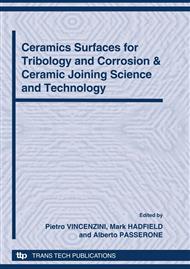p.83
p.88
p.98
p.108
p.115
p.125
p.135
p.145
p.151
Temperature Modeling for Friction Welding Process between Ceramic and Metal
Abstract:
Numerical model of friction welding between ceramic and metal rods are established to predict temperature rises during the initial phase of the process. In this study alumina(ceramic) and mild steel(metal) rods are used and joined with aluminium sacrificial interlayer. The workpieces are welded together by holding alumina still, while rotating the steel attached with aluminium piece under influence of an axial load which creates frictional heat in the interfaces. The transient thermal response in welding is hard to model analytically. Generally, heat is dissipated over time scales of less than two seconds. For the thermal model, an explicit one dimensional (1-D) finite difference (FD) method is utilized to approximate the heating and cooling temperature distribution of the joined dissimilar rods. The preliminary predictions are compared to actual thermocouple data from welds conducted under identical conditions and are shown to be in fair agreement. Even though the FD method proposed in this study cannot replace a more accurate numerical analysis, it does provide guidance in weld parameter development and allows better understanding of the friction welding process.
Info:
Periodical:
Pages:
115-124
Citation:
Online since:
October 2010
Price:
Сopyright:
© 2010 Trans Tech Publications Ltd. All Rights Reserved
Share:
Citation:


